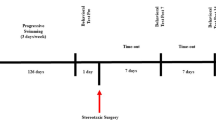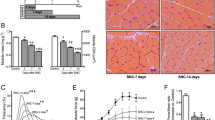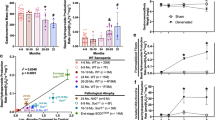Abstract.
Oxidative stress, as determined by increased lipid peroxidation, has been implicated in the pathology of myotoxicity. As a model system to study the response of muscle to oxidative insults, we have studied the effects of diisopropylphosphorofluoridate (DFP)-induced muscle hyperactivity on levels of nitric oxide (NO) and energy metabolites in rat skeletal muscles. In in vivo experiments, citrulline levels as indicators of NO and NO synthase (NOS), and ATP and phosphocreatine (PCr) as indicators of mitochondrial dysfunction, were determined using HPLC methods 15 min, 30 min, 60 min, 2 h, and 24 h after intoxication. Within 15 min of DFP exposure, with onset of fasciculations, citrulline levels were significantly elevated in all three muscles [soleus, extensor digitorum longus (EDL), and diaphragm]. Maximum increases in citrulline (272–288%) were noted 60 min after DFP injection. At this time point, acetylcholinesterase activity was reduced by 90–96% (soleus < diaphragm < EDL). The levels of ATP and PCr were maximally reduced (30–43%), and total adenine nucleotides, and total creatine compounds showed declines. The findings revealed that the increase in NOS activity and NO was greater than the decrease of ATP and PCr. Since memantine (MEM) has been shown to reduce nerve and muscle hyperactivity, we have studied the possible protective effect of MEM on the DFP-induced biochemical changes. Pretreatment with MEM (18 mg/kg s.c.) and atropine sulfate (16 mg/kg s.c.), 60 min and 15 min, respectively, before DFP injection prevented the increase in citrulline and muscle hyperactivity and the decrease in ATP and PCr. These data suggest that free radical reactions by depleting high-energy phosphates may be initiating the cascade of events leading to myotoxicity during DFP-induced muscle hyperactivity.
Similar content being viewed by others
Author information
Authors and Affiliations
Additional information
Electronic Publication
Rights and permissions
About this article
Cite this article
Gupta, R.C., Milatovic, D. & Dettbarn, WD. Involvement of nitric oxide in myotoxicity produced by diisopropylphosphorofluoridate (DFP)-induced muscle hyperactivity. Arch Toxicol 76, 715–726 (2002). https://doi.org/10.1007/s00204-002-0400-4
Received:
Accepted:
Issue Date:
DOI: https://doi.org/10.1007/s00204-002-0400-4




